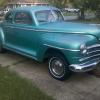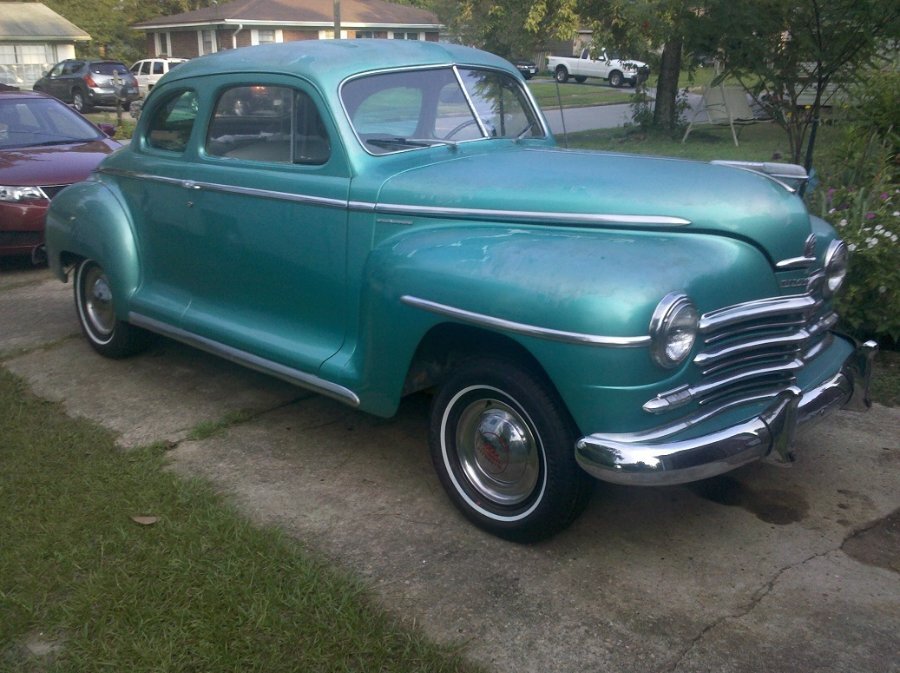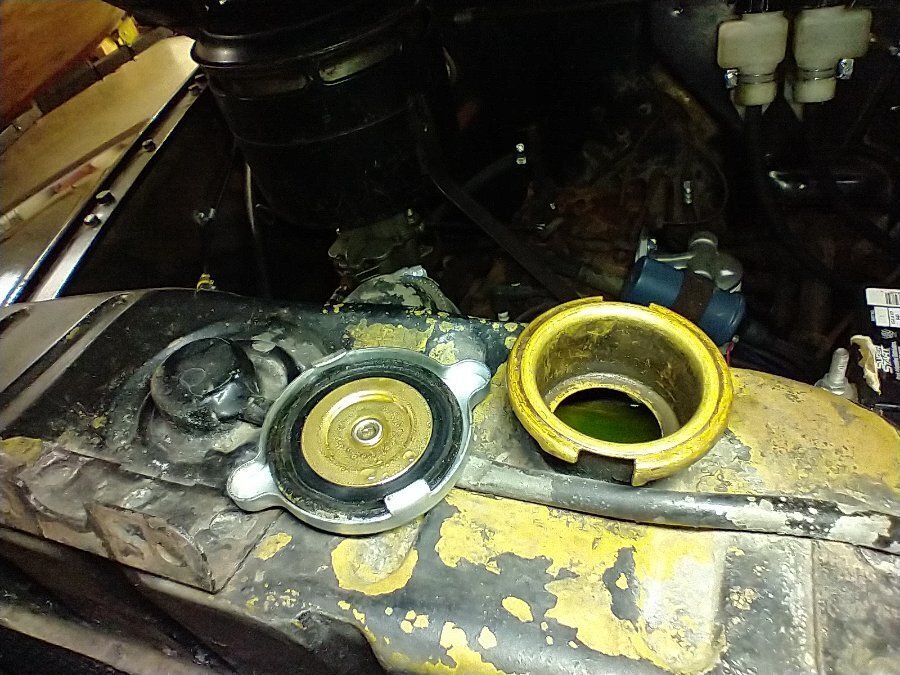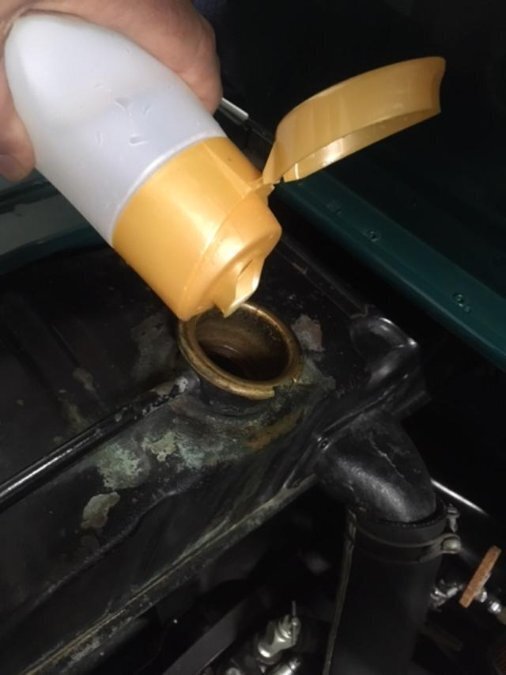-
Posts
953 -
Joined
-
Last visited
-
Days Won
6
Content Type
Links Directory
Profiles
Articles
Forums
Downloads
Store
Gallery
Blogs
Events
Everything posted by soth122003
-
I think your confusion comes from the misunderstanding that this type of oil filter is not a full flow oil filtration system. Oil is not continuously going through the filter. It only goes through the filter when the oil pressure is greater than the resistance of the spring in the oil bypass valve. The shop manual is great on how to do things, but sucks on explaining the theory behind how it works. Originally these cars did not have an oil filter. It was a dealer option. The oil change interval was 2500-3000 miles (city). In dirt or gravel environments (rural) it was more often, probably 1000-1500 miles. These cars had a crankcase ventilation system that took air in at the oil filler cap and vented it through the downdraft tube at the back of the engine. This was to keep water and water vapor out of the oil. However it did not address the dirt and particulate in the oil. Hence the oil changes at shorter than todays interval with the sealed crankcase. On a warm engine the bypass oil filter only worked when the oil pressure was at higher at higher engine RPMs and the bypass valve was open. At low Rpms your oil pressure goes down and the bypass valve would close and the oil did not travel through the filter. This ties into the crankcase vent system which did not work at low speeds as it needed higher speeds to create a vacuum by having air rush past the down draft tube to create said vacuum. At 30-45 psi it is not a problem to force oil through that small hole. I think at the bottom of the riser pipe are couple more holes as well. As long as the holes are between the top and bottom of the oil filter the oil is forced to go through the filter. Since it is not a full flow system it does not need a lot of holes to return oil to the crankcase. That's also why when the manual calls for 5 quarts of oil, it's more like 5 1/2 with the oil filter because the oil in the filter does not drain back into the crank with the engine off even if the filter sits higher than the crankcase. On todays cars the oil always flows through the oil filter. Since it is a sealed system, dirt and debris can't be sucked in the crankcase. The longer interval for changes is for burnt oil and engine wear particulate to be changed out with new oil and a filter. That's my story and I'm sticking to it. Hope this helps. Joe Lee
-
Now you really remind me of my dad. My mom passed in 2017 and my Dad has only had his cat for constant company since. He will be 89 in March and hasn't been able to swing wrenches for the past 20 years. If not for that cat, I think my dad would have wasted away after a year or two. He is pretty healthy and that cat is the only thing keeping him going. Joe Lee
-
For most people the term "daily driver" means the car you drive every day to take care of errands, work or just the date drive with the spouse. For long distance trips, You want a dependable car that won't break down on the trip. This could be the vintage classic or the newer car. It all depends on you definition of reliable. Also the drivers age plays a lot into this consideration. At 20-late 30's, you are basically bullet proof and break downs are part of the adventure. At 40-50's the risk reward comes more into play. The old car might break down and do I want to risk it? At 60+ you think about yesteryear versus reality. I would love to do this but... If the car breaks down can I fix it on the side of the road, cause there are no known shops that wiil/can work on these old cars. I see Rich just posted a reply with some I the things I was going to add as well, so I'll Just say the daily driver is up to what you want to do with the car. I just bought my wife a 2024 Toyota. I hate the car but my wife loves it. The important thing is I bought the car for my wife and not me. For me it's too small (I'm 6'7 and my wife is 5'1) It has all the crap I hate in a car, collision avoidance, lane departure, and lots of other things that it will try and drive itself instead of me driving it. It is a reliable car and has a warranty that is good nation wide and can be fixed nation wide. My next car for myself will be a 40's era Mopar. It is uncomplicated and fun to drive, but it will have to be in great condition as I can't really do the heavy fixing due to health issues and older age. (It hurts to get up from the ground and I can't bend like I used to) Another thing is that a restored classic is about as expensive and the cheapest new car. With all this said, Buy a dependable car for the wife (even though she can't drive, you will want a car for her needs that will be your definition of dependable) and then get your car for yourself and have fun making memories with your wife. My dad was in you shoes for a few years before my mom passed at 87 from dementia. Now he has the memories from being with her doing the things they enjoyed while she could. Joe Lee
-
They make the curved glass for the 40-48 back glass. Might give them a call and ask. They also make the curved windshields for the later models Plymouths. Joe Lee
-
Try this site. Especially if you need all the glass. https://www.vendio.com/stores/bobsclassicautoglass/category/page=5/__http_host=www.vendio.com/catId=4144656 Joe Lee
-

Engine stalls as I approach a stop around 15 mph.
soth122003 replied to Tom Skinner's topic in P15-D24 Forum
You remind me of the Mr. Magoo movie with Leislie Nielson, when his nephew Waldo fixed Magoo's car by installing a prescription windshield so Magoo could see out because he wouldn't wear his glasses. I believe the car was a 40's model because the windshield was a flat glass 2 piece, if I remember right. The movie was hilarious and Nielson did a fantastic job as Magoo even down to the Jim Baccus voice. -
Can't really think of any drop in replacements. You might want to take a chance on a used one. Unlike the radiators in our cars the neater core (to the best of my knowledge) isn't honey combed like the rads. So even if a used one leaks, it can be a simple fix at a radiator shop. Joe Lee
-
Silver. At the top of the page click the tab for resources and then click the P-15 reference. Further down it will list the Body paint colors and the engine and accessory color for 1946-1949 Plymouths. Joe Lee
-

Correct height of coil springs for P15 four door sedan
soth122003 replied to Devendra's topic in P15-D24 Forum
The height sounds about right. The big issue is how high the car sat with the springs installed. Did it sit low or high? If it sat low the springs are probably tired and compressed. If it sat high, they are probably ok. Some people like to remove a coil from the spring to get the car to sit even or just a little low to improve the looks of the car. On this pic you can see how high my P-15 sits. I will probably cut one coil out of the spring to lower it about 2 inches. This should make the car have a more level look instead of the high sitting look it currently has. Hope this helps. Joe Lee -
Just make sure when you remove the fill tube, you plug the hole with a rag or stopper of some sort to keep the crud out. Joe Lee
-
Here you go Keith, something that will fit in your garage and keep with the theme you have going. 1938 Knucklehead. Get a sidecar for it and take the wife out for ice cream. Joe Lee
-
Now you guys are just showing off, like the kid down the street who got all the cool toys for Christmas while you get new underwear.. Another car or two, please. Be happy with what you have. My garage is just big enough for me to change my mind in, so the only way I get something new is to move. Now GET OFF my lawn and SLOW down there's kids around. Harumph and humbug. Merry Christmas. Joe Lee
-
Merry Christmas and Happy New year to all. Joe Lee
-
The WD 40 will work very short term. It is too thin to make a long lasting barrier as it will evaporate and or run off leaving a to thin protection that will be over come by humidity and water vapor in an area. All most all tech bulletins and manuals I've read will say to use soapy water to clean and then warm/hot to rinse. Then apply a film of oil, grease, primer what have you to prevent rust from forming. Everything I have read not one mentioned WD40. Joe Lee
-
Don't know for sure. My post reflects the Plymouth specifically and other cars generally. Your service manual will tell you for sure. Joe Lee
-
Since you didn't specify a model for you car, Andy's is probably your best bet. A quick check for clutch parts on the search engine shows that most ads sell kits. If all you need is the disk, Andy's has them for about $115 to $150 depending on the size. That was my case. I didn't need the pressure plate so And's was about my only option as most others sold a kit with the plate included. Joe Lee
-
Andy is right. The cooling systems were non pressure systems up to 1950, at least on the Plymouth. After 1950 they were installed to increase the pressure and raise the boiling point of the water. Since you changed to an aluminum rad, it has an overflow only when the cap pressure is raised and exposes the overflow tube in the neck on the rad. On the old rad's the overflow tube is at the top of the rad not in the filler neck of the rad. This allows the steam to gather at the highest point and then bleed of the pressure of the steam and not the water in the rad. The top pic you can see the over flow tube at the top of the rad and not attached to the filler neck. The pic on the bottom has the tube coming out of the filler neck. Hope this helps. Joe lee
-
If you are that worried about the cylinder. Go to Harbor Freight, spend $25 and buy a cylinder hone. Smear the cylinders with engine oil and re crosshatch the bores. With a hone it will take you about 2-3 minutes per bore and it will remove the spots and maybe clean up the pits. Also a hone takes a long time to remove even a .001" as it is a polishing tool used to clean and polish bores. It is not used as a bore tool to remove material to resize the bore, so you will not make a difference on the bore size. As far as WD 40 goes, it is a Water Displacement formula #40 not a true lubricating compound, though most people use it as such. As mentioned before with the bores and other machined areas, it is best to use engine oil to keep it rust free. Joe Lee
-
If you're reading a thickness of .125" it is probably the clutch disc facings. Those polygonal rectangle shapes that are on the disc. I replaced my disc this past summer and my new disc was about .325" thick. It was over 1/4" and less than 3/8" thick. Probably about 1/4" for the facings and 1/8" for the disc itself. I don't really remember except the new disc was about twice as thick as the worn out one. Joe Lee
-
It's 1/8 inch. The value for thickness on these old cars is measured in thousands of an inch. It is a digital representation of a fraction. I believe most blueprints and engineering specs use this. You can just google the conversion charts and input the digit and convert to a fraction or in your case metric. Since your in France, you use the metric system. In the U.S. at the time of these cars S.A.E. was the standard unit of measurement. Joe Lee
-
super/turbo chargers to increase HP in engines for aircraft, but it took a while to put on cars. I believe they had them before WWII, but they weren't mainstream. Mostly for air racing. Fuel injection during Korea for jet aircraft. But aircraft are injected into a single chamber, but it would be a few years before they said Hey maybe we can do this for cars. Joe Lee
-
Since your engine is free standing like that, you can position it for best spray application. Then move it for the next shot. When you are ready use the brushes and scrub the passages and other areas. When done, I would use boiling water poured into the passage then move it to the next passage/spot. After all that I would get some fogging spray or light oil and use it in the passages to prevent any rust build up while waiting to assemble the engine. I will say that Easy Off is no joke on baked on oil and sludge. prior to the self cleaning oven this was a once a week chore for moms or young uns on an allowance. Joe Lee
-
Dave beat me to it. Use those and a can of oven cleaner. Just follow the directions. Then when done rinse well. Matter of fact, spray them fist and then other areas of the block and you can watch the progress on the outside to decide when to flush the passages. best guess would about 2-3 hours. Joe Lee
-
In the Plymouth service manual, pg. 112 bottom picture. Joe Lee
-
Hey Sniper I love my wife too, but the 50K insurance policy.... Actually my wife hates riding in the P-15, she's like 5'1" and her feet don't quite make it to the floor, so every corner she slides across the seat back and forth. Some one once asked me "What would you do if your wife left you or died?' I told them I'd starve to death. She takes real good care of me. Joe Lee







